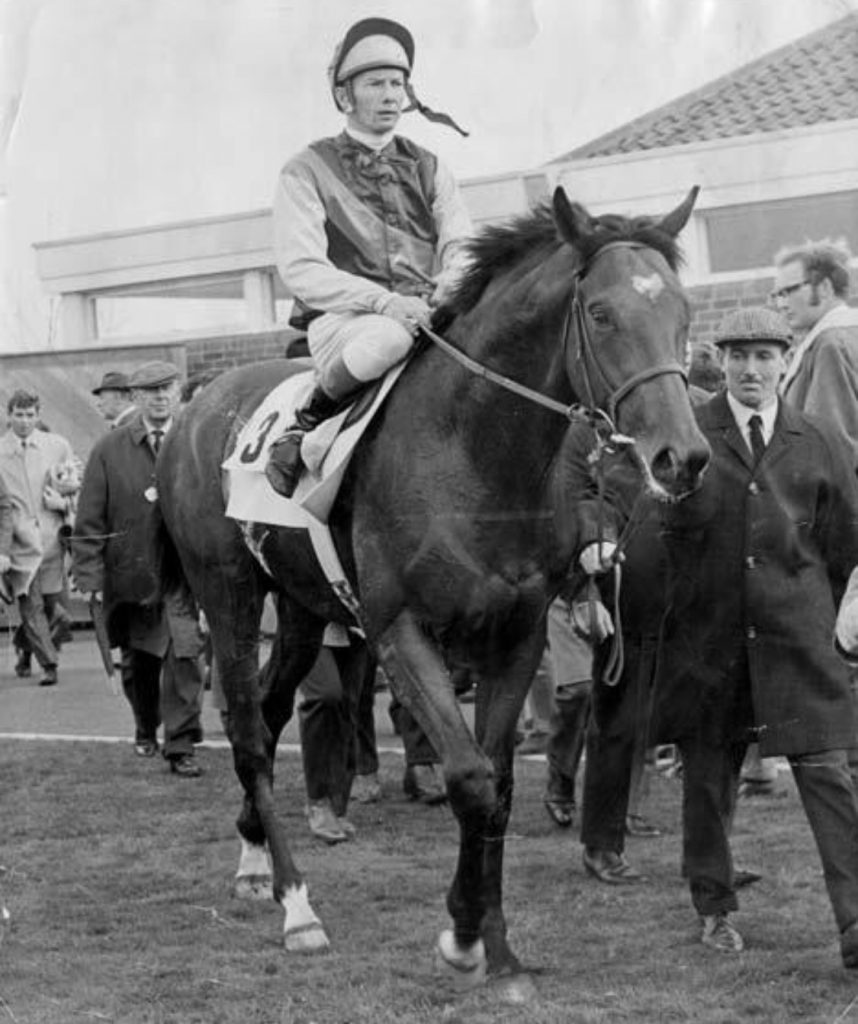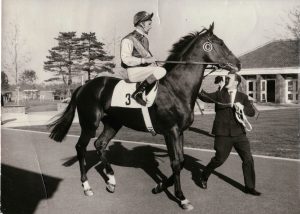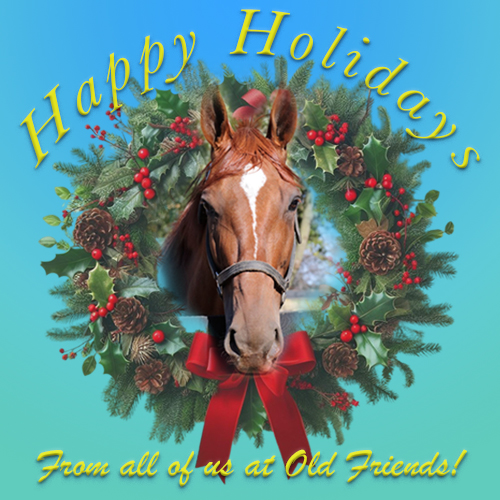
If such a horse were alive and racing today, he would have the full attention of the world. Canadian-bred, Irish-trained, and standing his entire stud career in the United States, Nijinsky left his presence everywhere he went. Known as Europe’s Secretariat, he is regarded by many experts to be the greatest flat racer Europe saw in the 20th century. His success kickstarted the reign of the iconic O’Briens and was one of the most legendary horses to touch the holy grounds of Ballydoyle. Nijinsky was a horse for the world. He even had a heart on his forehead.
On February 21, 1967, a sturdy bay colt with three white feet and a white star on his forehead to match, was born. E.P. Taylor’s, Windfields Farm had the perfect formula to breed champions. A cross between Northern Dancer and Flaming Page, Nijinsky was destined for greatness from the start. Northern Dancer had only started his second season at stud and was still unproven but Taylor had the utmost confidence in the breeding. Flaming Page was another one of Windfield’s homebreds, a champion herself. She took Canada by storm in 1962 after winning the Canadian Oaks and the Queen’s Plate just 8 days apart. That same year, Flaming Page also ran second in the Kentucky Oaks and successfully locked up Canadian Champion 3YO Filly. She grew into a big, boxy mare with age, a far cry from her mate Northern Dancer. These two champions who could not be more physically opposite, produced a colt who could not be more physically perfect.
 As a yearling, Nijinsky was purchased for a small $84,000 by American businessman Charles Engelhardt Jr. He was picked out by Vincent O’Brien, a famed National Hunt trainer who a few years prior had switched over to training on the flat. Nijinsky soon had left Canada for the mountains in Ireland where he would train at O’Brien’s famed center, Ballydoyle.
As a yearling, Nijinsky was purchased for a small $84,000 by American businessman Charles Engelhardt Jr. He was picked out by Vincent O’Brien, a famed National Hunt trainer who a few years prior had switched over to training on the flat. Nijinsky soon had left Canada for the mountains in Ireland where he would train at O’Brien’s famed center, Ballydoyle.
The trainer and owner duo knew this colt would be a special one from the start and needed a name to measure up. The legendary Russian ballet dancer Vaslav Nijinsky had died 18 years prior, and it was said that on his deathbed he declared he would return someday reincarnated as a horse. With graceful, long legs and a mysterious personality to match his human counterpart, Nijinsky could not have found a more fitting name.
Like many other colts at 2, Nijinsky was extremely unruly. He was famous around Ballydoyle for throwing riders and his reluctance to come out of his stall in the mornings. He certainly was not a favorite of O’Brien’s staff, who referred to him as the “ornery Canadian.” At one point in his early training, there was a moment where O’Brien thought Nijinsky may not even start at 2. Nijinsky finally made it to the races in June of 1969 and went unbeaten that year. In his last start of the season, Nijinsky and Lester Piggott teamed up for the first time.
The colt that excited many at 2 was poised to electrify Europe at age 3. Nijinsky had blossomed and soon became the darling of the British media after winning the 1970 2,000 Guineas with commanding ease. Shortly after, they dazzled them again in the Epsom Derby in a performance that Piggott called “one of the greatest races in the history of this race, and certainly Nijinsky is one of the greatest winners.” In his next two races, Nijinsky bounced between both of his regular jockeys, Liam Ward and Lester Piggott, winning both the Irish Derby and the King George VI and Queen Elizabeth Stakes at Ascot. Nijinsky had defeated older for the first time, and in fact was the only 3YO in the race at Ascot. Now with a perfect 10 for 10 record, the plan was to rest Nijinsky until the Arc.
Like every other picture perfect story, at some point disaster is bound to strike. While Nijinsky was at Ballydoyle in the summer, he was struck with a very violent case of ringworm. The skin condition became so bad that Nijinsky was virtually bald. Even small training saddles would cause Nijinsky’s skin to bleed, so he was hand walked and lunged while recovering. The parasite took a lot out of the horse, but his owner still wanted to forge forward with plans for the Arc. Engelhardt wanted badly to see his colt try for the British Triple Crown in a last minute decision. The British Triple Crown was seen even in the 1970’s as an afterthought, as the St. Leger was not as prestigious as it once was. The Triple Crown had not been won or even attempted since Bahram in 1935. Many factors steered O’Brien away from the prospect of running in the St. Leger. The St. Leger was ran a quarter of a mile longer than the Arc, and was ran just a month ahead of time. Although Nijinsky’s health was still in question, O’Brien got the colt as ready as he could and shipped him to Doncaster for the less than ideal prep.
Nijinsky went off as the favorite against an ordinary field and became the 15th British Triple Crown Champion. A win that was supposed to be most celebrated came at a harsh price. The newly minted legend lost 29 pounds after the St. Leger, a staggering amount for any horse. Despite this obvious roadblock, the camp forged on to the Arc.
Nijinsky encountered a world of trouble in the 1970 Arc. He was drawn widest of all in a huge field, was too far back early on, and lunged away from Piggott’s whip in the stretch. Nijinsky’s awful trip landed him second by a head to Sassafras, who himself had sat the perfect trip and saved all the ground. Many thought Nijinsky still ran one of his best races that day and was valiant in defeat. Vincent O’Brien and the rest of the Nijinsky team never got over the loss and only raced the colt once more in the Champion Stakes where he was soundly beaten. Nijinsky’s accomplishments in 1970 earned him Timeform Horse of the Year as well as British Horse of the Year.
The story of Nijinsky’s racing career is a long and dramatic tale, but must be told in its entirety to appreciate his worth at stud. During and shortly after his career the horse had the same rockstar mantra as Secretariat. A film titled A Horse Called Nijinsky was created soon after his retirement as a gift to his fans. Queen Elizabeth II even had a special affinity for Nijinsky and loved to be in his presence. Her Majesty visited Claiborne Farm several times while Nijinsky was there, and always asked “Will we see Nijinsky?” Both Vincent O’Brien and Lester Piggott, who were considered Europe’s greatest at their trades, said Nijinsky was the best horse they ever worked with. Lester Piggott is often quoted about the horse’s mysterious and eerie behavior saying he “never talked to me and he always looked right through me.” Vincent O’Brien was already considered a master trainer by the time the horse had landed in his stable, but his operation exploded after their success. Shortly after Nijinsky’s retirement, Vincent O’Brien, his son-in-law John Magnier, and prominent owner Robert Sangster went on to establish what would be known as the ‘Coolmore Syndicate.’
Despite being the darling of Great Britain, Nijinsky was syndicated and purchased for stud duties by US interests. Syndicated for a large $5,440,000 (around $35 million today when adjusted for inflation), the legendary Claiborne Farm would become his new home. At the time of the purchase, Claiborne Farm was the top stud farm in the world. The illustrious farm was already standing virtually every top dirt horse in America but were really lacking a stallion with a great turf backing. With almost unlimited resources, Nijinsky was a perfect stallion to add. By that time Northern Dancer’s bloodlines were highly sought after and few of his sons had reached stallion maturity. Nijinsky was shipped to the US to begin stud duties in 1971 and would be registered there as ‘Nijinsky II.’ Back then horses that had not raced in the US but were standing there were listed with roman numerals at the end of their name. Other examples : Blenheim II, Challenger II, and Sir Gallahad III.
Nijinsky was off and running very fast at stud. Claiborne Farm had immediate confidence in him and he was offered top mares immediately. He was one of the first of Northern Dancer’s sons to reach stud, and would be the first to determine the influence of the line. True to Nijinsky fashion, he did not disappoint. In his first crop he produced Green Dancer, a multiple G1 winner and a fantastic future stallion in his own right. Nijinsky would produce many stakes winners in his long stud career, but perhaps his best and most recognized foal was a colt born in 1983.
As a stallion with turf talent and a top heavy pedigree for the grass, the fact that Nijinsky’s best colt was a dirt horse only adds to his versatility. Ferdinand was a decent 2YO but soon soared to new heights at 3. He captured the 1986 Kentucky Derby in style and went on to race at many distances that year as well as defeat older company. At age 4, Ferdinand continued his ascent to greatness in capturing the 1987 Breeders’ Cup Classic, defeating the great Alysheba in a thrilling finish. Ferdinand’s unfortunate fate must also be mentioned due to the many great things that came of it. The Ferdinand Fee was developed to protect all horses who were sold or leased overseas, and many horses currently are under this clause. Ferdinand’s death also was a catalyst in the development of the equine retirement farm, Old Friends.
The same year Ferdinand won the Kentucky Derby, Nijinsky also was the sire of the Epsom Derby winner, Shahrastani. Shahrastani also went on to win the Irish Derby. Nijinsky remains the only stallion to sire winners of the two prestigious races in the same year. In addition to Ferdinand, he sired two other Breeders’ Cup Champions, 1989 Sprint winner Dancing Spree and 1990 Mile winner Royal Academy. Other notable champions and stakes winners sired by Nijinsky include : De La Rose, Caerleon, Golden Fleece, Ile de Bourbon, Princesse Lida, Kings Lake, Niniski, Lammtarra, Quiet Fling, Shadeed, Cherry Hinton, Seattle Dancer, Sky Classic, Solford, and Whiskey Road.
Nijinsky was a stallion that we can definitely consider to be a ‘Sire of Sires.’ Although some of his best sons were met with moderate success, Caerleon, Green Dancer, Baldski, Royal Academy and Shadeed turned out to be outstanding stallions themselves. Caerleon went on to be the Leading Sire in Great Britain and Ireland in both 1988 and 1991. Green Dancer was the Leading sire in France in 1991. Royal Academy really was the only son of Nijinsky to keep his father’s line still going to this day. He sired two important sons who are still producing, Val Royal and Bel Esprit. Bel Esprit is widely known as the sire of the great Black Caviar, making her a direct descendent of Nijinsky.
Nijinsky is widely celebrated as a fantastic broodmare sire. He was crowned American Leading Broodmare Sire in both 1993 and 1994. His daughters went on to produce several champions and their influence is felt heavily in today’s thoroughbreds. Nijinsky’s G1 winning daughter Maplejinsky went on to produce Triple Tiara winner Sky Beauty. Maplejinsky is also the granddam of stakes winners Tale of Ekati, Pine Island, Country Hideaway, and Matlacha Pass (dam of Point of Entry and Pine Island). Through his daughter Ruby Slippers, Nijinsky is the broodmare sire of Rubiano and the mare Tap Your Heels, giving him direct influence in one of the world’s top stallions, Tapit. Nijinsky is also the broodmare sire of : Fantastic Light, Flawlessly, Hussonet, Hurricane Sky, Brave Warrior, Russian Rhythm, Alpha, Jade Robbery, Numerous, Heavenly Prize, Colonial Affair, Narrate, Broken Vow, and many more.
After an illustrious stud career that spanned just over 20 years, Nijinsky began to show signs of slowing down. He was beginning to act sluggish, and was experiencing chronic arthritis and laminitis. On April 16, 1992 the decision was made to humanely euthanize the great stallion at age 25. Unlike most horses, Nijinsky is one of a small handful that is buried in his entirety. Most of the stallions and mares buried at Claiborne are not buried whole, but this final act of respect was bestowed upon him. Nijinsky is buried in Claiborne’s equine cemetery between Secretariat and Riva Ridge.
Nijinsky’s legacy as a race horse and as a stallion can still be felt to this very day. He was the son of Northern Dancer that left his mark on the breed the most physically. Nijinsky is the only son of Northern Dancer that was much larger than his sire. All of Nijinsky’s foals were large and very distance oriented. Most other descendants of Northern Dancer were smaller and speedier types. This large difference aids when Northern Dancer lines are inbred and crossed, which often they are.
Nijinsky and several other of Northern Dancer’s sons did one thing he could not do. Sire a winner of an American Triple Crown race. Only one son sired that Kentucky Derby winner, that stallion being Nijinsky. He also remains the only son of Northern Dancer to sire a winner of the Breeders’ Cup Classic.
Next Installment – Stallion Dynasties : Lyphard



